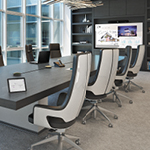
MEETING ROOM
Digital ecosystems for collaborative workspaces
We design Meeting Rooms that integrate AVC hardware, software and automation solutions to physical environments, dedicated to sharing, collaboration and comparison.
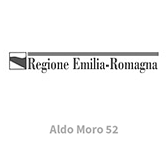
The main headquarters of the Emilia-Romagna Region has been located in Viale Aldo Moro 52, within the city's exhibition district, since 1993. It is in one of the towers designed by Japanese architect Kenzo Tange.
For several years, the Press Office and Communication Departments have continuously renewed their dissemination activities. This process has led the Region to recognize the need for multimedia spaces and technological infrastructures to achieve its communication goals.
The spaces at Viale Aldo Moro 52 have undergone a significant renovation aimed at giving a new identity to the Region’s headquarters, embracing sustainability and innovation.
Based on these two main drivers, we envisioned the Region’s headquarters as a large multimedia hub where technological solutions interact with and integrate into the furniture and setups.
The result is a building designed to facilitate meaningful and efficient communication and collaboration, where the spaces are enhanced and completed by multimedia systems, audio, video, and lighting equipment to create advanced and integrated Digital Workspaces
Our technicians designed the audio-video-lighting architecture and networking infrastructure for the Emilia-Romagna Region's spaces based on four key principles:
The entrance hall is the first point of contact for external users with the Region’s headquarters. To meet the institution's needs for information, transparency, and hospitality, we installed a Digital Signage System behind the reception desk. This system consists of a large 32:9 4K LED wall and two BrightSign Players that manage the digital content schedule and display on screens.
Nomen omen: the multifunctional room was designed to create a fully reconfigurable environment that can adapt to any specific use at any given time. In addition to furniture – chosen with this goal in mind – the technological architecture follows this concept, featuring flexible and interoperable audio and video systems.
The core of the room’s visual system consists of two 98” multi-touch displays, paired with a third 86” interactive monitor on a cart that can be easily moved based on the needs.
The beamforming ceiling microphones are digitally connected to the room’s audio system via Dante output, ensuring high-quality sound in enterprise AV conference environments.
Three PTZ cameras for recording and streaming content complete the AV system. These cameras are strategically positioned to easily manage video captures for all types of meetings.
The Press Room is a high-multimedia environment with two UHD 4K 98” displays configured in dual-display mode and a dedicated micro-control room.
From a technological standpoint, this room features three PTZ cameras and a beamforming ceiling microphone system, similar to the multifunctional room. The infrastructure is designed to send all camera and microphone signals, contributions from PCs, and other external sources to the video control room for editing and broadcasting.
With the TV Studio, the Emilia-Romagna Region aimed for excellence. Similar to the studios used by national broadcasters, this one allows for live broadcasts, zero-latency recording and streaming, and the organization of talk shows.
We designed and built two large LED wall screens framing the space, giving the speakers an immersive feel. Both LED walls, with a pixel pitch of 1.9, feature angled viewing surfaces and can be used as backdrops with moving images or green screens, allowing the Control Room to insert digitally recreated contextual images.
The TV Studio is completed by a comprehensive microphone infrastructure and a lighting system composed of 14 different types of LED studio lights mounted on a custom-designed ceiling suspension system.
The dedicated Control Room combines audio, video, and lighting control and can coordinate all events.
An advanced NDI production system natively processes video content, ensuring video signal management, control, and broadcasting. Monitoring is done in real time via a smart video hub router, allowing for real-time video switching.
The audio control features a digital mixer integrated with a Dante distribution system, enabling efficient live sound distribution and in-studio recording. The lighting console controls the studio’s illumination via a USB connected to a PC.
The entire audio, video, and environment infrastructure is managed through Triatic. This control platform allows users to autonomously manage all aspects related to the workspace from the Touch Panel present in each environment.
Moreover, Triatic is not tied to any specific physical device, meaning it’s not affected by hardware issues.
Through user-friendly graphic interfaces and shared usability logic developed by our UI/UX Designers and the Region’s technicians, users can interact with the technological devices, launching work sessions, meetings, and events, managing room darkening, lighting, and acoustics systems, and sharing specific content through BYOD and BYOM systems.
The technological spaces designed and set up for the Emilia-Romagna Region, although not defined as “mission critical,” are still considered strategically important for the institution and its stakeholders.
For this reason, Touchwindow has provided a tailor-made service to help clients meet their assistance needs.
In addition to continuous technical monitoring through our internal N.O.C., a dedicated Help Desk service offers remote or telephone support in case of emergency.
If the Client needs to open a ticket, our Ticketing platform is available online. Users can submit assistance requests to the Service Desk using unique credentials to access the platform.
https://www.sistemi-integrati.net/wp-content/uploads/2024/08/ECSB24.pdf
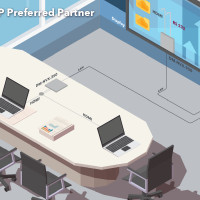
We’re now a recognized partner of Crestron: expert consultants in the design of AV-over-IP solutions through DM NVX.
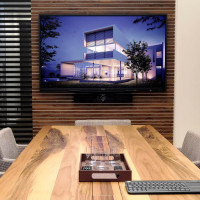
We proudly announce our Partnership with Poly
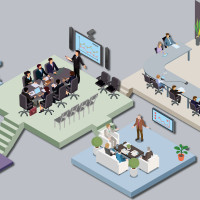
When the workplace becomes a lifestyle